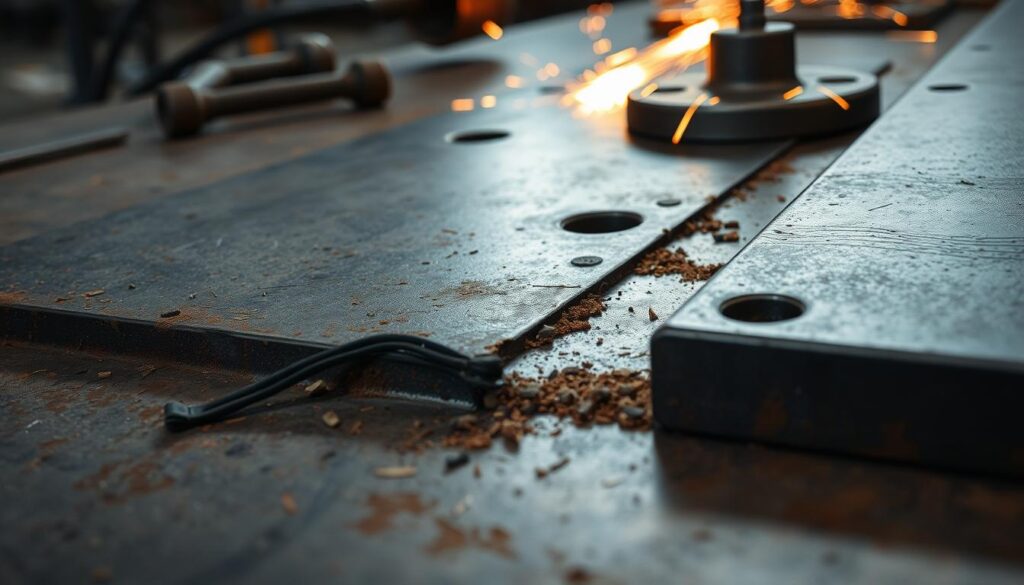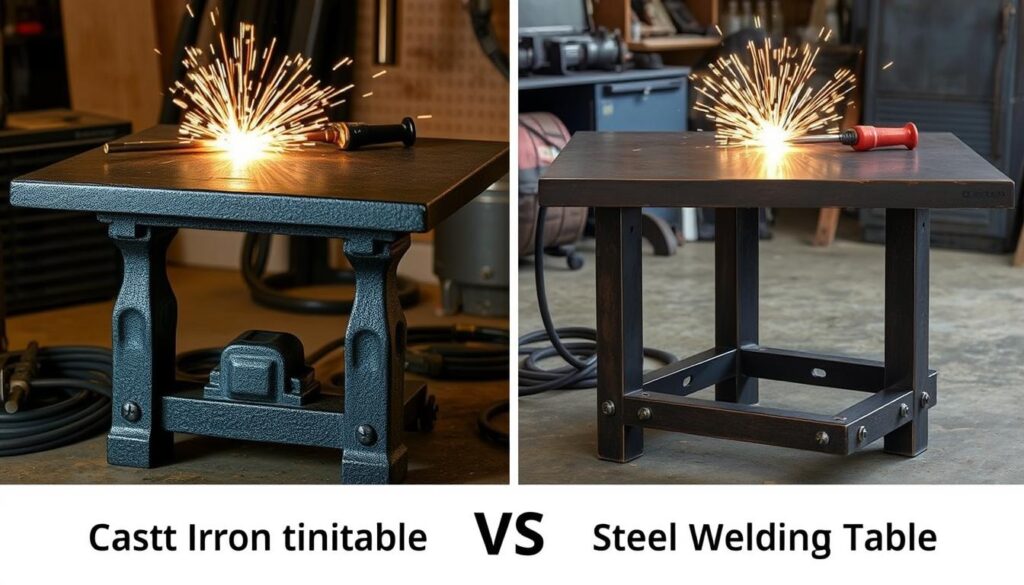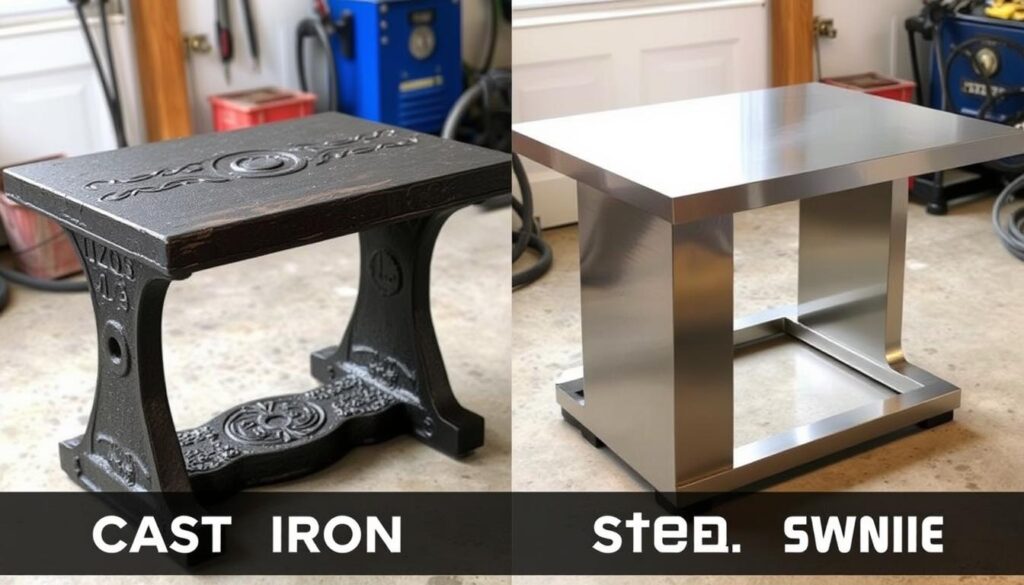At KT-Welding Table, we know how crucial the right material is for welding. When picking a welding table, you face a choice between cast iron and steel. Each has its own set of pros and cons. We’ll look at the main differences, like how they handle heat and impact, and their overall performance.
A welding table is key for any welding job. It gives you a flat, stable place to work.
Exploring welding tables means understanding both cast iron and steel. Cast iron tables are great at spreading heat, perfect for many welding jobs. Steel tables, however, can take a lot of impact and are good for tough tasks. At KT-Welding Table, we want to help you decide between cast iron and steel.
Whether you’re using a cast iron or steel table, the surface is vital. We aim to give you the info to pick the best table for your needs. This includes the type of weld, material thickness, and desired outcome. Knowing the differences helps you choose the right tool for better results and more productivity.
Understanding Welding Table Materials
We explore the materials used in welding tables. The surface of the table is key, as it affects weld quality. Cast iron and steel tables are popular, each with its own strengths.
Cast iron is strong and durable. Steel tables, especially carbon steel, are more affordable.
Choosing a table depends on spatter resistance and heat distribution. Carbon steel is good for spatter resistance. Cast iron is stable and flat, reducing warpage under heat.
What Makes Cast Iron Unique
Cast iron is an iron alloy with lots of carbon. It’s brittle but good at conducting heat. Its density makes it stable and reduces vibrations during welding.
Steel Properties for Welding Tables
Steel tables, like those made from carbon steel, have benefits. They’re lighter and more affordable. Steel also conducts heat well, reducing distortion in welds.
Material Composition Differences
The makeup of welding tables affects their performance. Cast iron combines iron and carbon. Steel combines iron, carbon, and sometimes chromium and other alloys. Knowing these differences helps choose the right table.

The table below shows key differences between cast iron and steel tables:
| Material | Thermal Conductivity | Strength | Portability |
|---|---|---|---|
| Cast Iron | High | High | Low |
| Carbon Steel | High | Medium | High |
In conclusion, picking a welding table depends on several factors. These include the welding type, portability needs, and budget. Knowing the differences between cast iron and steel helps make the right choice.
Cast Iron vs Steel Welding Table: A Direct Comparison
Choosing between a cast iron and a steel welding table involves several factors. Welding processes need a stable and durable surface. Both cast iron and steel can offer this, but they differ in properties.
A cast iron welding table excels in heat distribution during welding processes. On the other hand, a steel welding table is more durable and can handle heavy use. Yet, steel is more likely to rust and corrode if not maintained well.
Some key differences between cast iron and steel welding tables include:
- Thermal conductivity: cast iron has higher thermal conductivity than steel
- Impact resistance: steel is more resistant to impact than cast iron
- Corrosion resistance: steel is more resistant to corrosion than cast iron, especially when properly maintained
Cost-wise, cast iron welding tables are often cheaper than steel welding tables. But, remember to consider the cost of a welder and other equipment. Your choice between cast iron and steel will depend on your specific needs and preferences.

Thermal Properties and Heat Distribution
Thermal properties are key in welding tables. We’ll look at cast iron and steel tables, focusing on heat conductivity and thermal expansion. Cast iron tables are great for even heat distribution, which helps in making better welds. This is why they’re perfect for welding that needs precise temperature control.
Cast iron tables also resist spatter well, making cleanup easier than steel tables. This is a big plus when using a fixture table, as spatter can mess up the workpiece’s accuracy. Steel tables, on the other hand, expand less with heat, making them good for some welding tasks.
The thermal properties of welding tables greatly affect how well they work. A table that conducts heat well can prevent warping or distortion. But a table that doesn’t conduct heat well might need extra cooling to avoid overheating. So, when picking a welding table, think about the material’s thermal properties and how they’ll impact your welding.
Here are some key thermal properties to consider when selecting a welding table:
- High thermal conductivity for efficient heat distribution
- Resistance to spatter for easier cleanup
- Thermal expansion characteristics to prevent warping or distortion
- Impact resistance to withstand heavy use
Knowing the thermal properties of cast iron and steel tables helps us choose the right one for our welding. Whether we’re using a fixture table or a standard work piece, the right thermal properties can greatly improve our weld quality.
| Material | Thermal Conductivity | Thermal Expansion | Spatter Resistance |
|---|---|---|---|
| Cast Iron | High | Prone to expansion | Resistant to spatter |
| Steel | Lower | Less prone to expansion | Less resistant to spatter |
Durability and Longevity Factors
We look at how long cast iron and steel welding tables last. It’s key to keep them from rusting and to work smoothly. Storing them in a controlled place is crucial for their longevity and optimal performance.
Several things affect how long a welding table lasts. These include what it’s made of, how much it can hold, and how it’s treated. Cast iron tables can rust but can be saved with a special treatment. Steel tables also rust but can be protected with galvanizing or powder coating.
Here are some tips to keep your welding table in top shape:
- Store it in a controlled environment to prevent rust and corrosion
- Apply a surface treatment to protect the table from rust and corrosion
- Regularly clean and maintain the table to ensure a smooth working surface
By following these tips, you can make sure your welding table lasts long and works well. Keeping it in a controlled place also stops rust and keeps the surface smooth. This is key for great welding results.
Surface Properties and Spatter Resistance
Welding tables need to have good surface properties and spatter resistance. The surface treatment helps prevent rust and corrosion. This keeps the surface safe and the workpiece in good condition.
Spatter Adhesion Characteristics
How well a surface resists spatter is key. A surface that doesn’t hold spatter well makes welding more efficient. For example, it can save time on cleaning and boost production.
Surface Treatment Options
There are many ways to treat a surface, like using an anti-stick coating. This coating can cut spatter adherence by over 50% right away. It’s a great way to improve surface quality.
Maintenance Requirements
Keeping a welding table in good shape is important. This means cleaning it often and using protective products. Doing this keeps the surface treatment effective and protects the workpiece.
Cost Analysis and Value Proposition
Choosing between cast iron and steel welding tables requires a cost analysis and understanding of value. Cast iron tables cost more upfront but last longer. Steel tables are cheaper at first but need more upkeep and don’t last as long.
Maintenance is a big part of the cost. Cast iron tables are tough and don’t wear out quickly. Steel tables, however, need more care, which adds to their cost. Cast iron’s quality and performance make it worth the extra money.
The table below shows the main points to think about when comparing cast iron and steel tables:
| Factor | Cast Iron Tables | Steel Tables |
|---|---|---|
| Initial Cost | Higher | Lower |
| Maintenance | Less frequent | More frequent |
| Longevity | Longer | Shorter |
| Value Proposition | Higher quality and performance | Lower cost, but lower quality and performance |
In summary, while steel tables might seem cheaper at first, cast iron tables are a better deal in the long run. Their durability, long life, and less need for upkeep make them worth the extra cost. They offer better quality and performance.
Conclusion: Making the Right Choice for Your Welding Needs
Choosing between a cast iron welding table or a steel welding table depends on your needs. At KT-Welding Table, we know each welder is different. We’re here to help you choose the best one.
Think about what matters most to you. Do you need something that holds heat well, is very durable, or has a smooth surface? We can help you find the perfect welding table. Consider things like the welding table surface quality, how heat spreads, and how it lasts over time.
Getting the right welding table can really change how you work. It can make your projects better and your work easier. Check out our cast iron and steel welding tables. Let us help you pick the best one for your space. We want to help you improve your welding skills and get great results.


